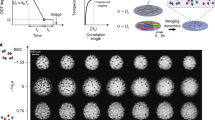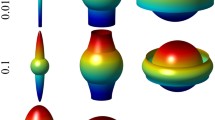Abstract
The Kibble–Zurek mechanism is a theoretical framework that describes the formation and scaling of topological defects in symmetry-breaking phase transitions. It was originally conceptualized for superfluid helium. The theory predicts that the number of quantum vortices should scale as a power law with the rate at which the system passes through the lambda transition, but demonstrating this effect has been elusive in experiments using superfluid systems. Here, we report the observation of Kibble–Zurek scaling in a homogeneous, strongly interacting Fermi gas undergoing a superfluid phase transition. We investigate the superfluid transition using temperature and interaction strength as two distinct control parameters. The microscopic physics of condensate formation is markedly different for the two quench parameters, as shown by the two orders of magnitude difference in the condensate formation timescale. However, regardless of the thermodynamic direction in which the system passes through a phase transition, the Kibble–Zurek exponent is identically observed to be about 0.68, in good agreement with theoretical predictions. This work experimentally demonstrates the theoretical proposal laid out for liquid helium, which is in the same universality class as strongly interacting Fermi gases.





Similar content being viewed by others
Data availability
Source data are provided with this paper. All other supporting data are available from the corresponding author upon request.
References
Kibble, T. W. Topology of cosmic domains and strings. J. Phys. A: Math. Gen. 9, 1387 (1976).
Zurek, W. H. Cosmological experiments in superfluid helium? Nature 317, 505–508 (1985).
Hohenberg, P. C. & Halperin, B. I. Theory of dynamic critical phenomena. Rev. Mod. Phys. 49, 435–479 (1977).
Kardar, M. Statistical Physics of Fields (Cambridge Univ. Press, 2007).
Zurek, W. H. Experimental cosmology: strings in superfluid helium. In Proc. Santa Fe Meeting of the Division of Particles and Fields of the American Physical Society (eds Goldman, T. & Nieto, M. M.) 479 (World Scientific, 1985).
Leggett, A. J. Quantum Liquids: Bose Condensation and Cooper Pairing in Condensed-Matter Systems (Oxford Univ. Press, 2006).
Goldner, L. S., Mulders, N. & Ahlers, G. Second sound very near Tλ. J. Low Temp. Phys. 93, 131–182 (1993).
Donner, T. et al. Critical behavior of a trapped interacting Bose gas. Science 315, 1556–1558 (2007).
Navon, N., Gaunt, A. L., Smith, R. P. & Hadzibabic, Z. Critical dynamics of spontaneous symmetry breaking in a homogeneous Bose gas. Science 347, 167–170 (2015).
Hendry, P., Lawson, N. S., Lee, R., McClintock, P. V. & Williams, C. Generation of defects in superfluid 4He as an analogue of the formation of cosmic strings. Nature 368, 315–317 (1994).
Bäuerle, C., Bunkov, Y. M., Fisher, S. N., Godfrin, H. & Pickett, G. R. Laboratory simulation of cosmic string formation in the early Universe using superfluid 3He. Nature 382, 332–334 (1996).
Ruutu, V. M. H. et al. Vortex formation in neutron-irradiated superfluid 3He as an analogue of cosmological defect formation. Nature 382, 334–336 (1996).
Dodd, M. E., Hendry, P. C., Lawson, N. S., McClintock, P. V. E. & Williams, C. D. H. Nonappearance of vortices in fast mechanical expansions of liquid 4He through the lambda transition. Phys. Rev. Lett. 81, 3703–3706 (1998).
Weiler, C. N. et al. Spontaneous vortices in the formation of Bose–Einstein condensates. Nature 455, 948–951 (2008).
Lamporesi, G., Donadello, S., Serafini, S., Dalfovo, F. & Ferrari, G. Spontaneous creation of Kibble–Zurek solitons in a Bose–Einstein condensate. Nat. Phys. 9, 656–660 (2013).
Donadello, S. et al. Creation and counting of defects in a temperature-quenched Bose–Einstein condensate. Phys. Rev. A 94, 023628 (2016).
Chomaz, L. et al. Emergence of coherence via transverse condensation in a uniform quasi-two-dimensional Bose gas. Nat. Commun. 6, 6162 (2015).
Ko, B., Park, J. W. & Shin, Y. Kibble–Zurek universality in a strongly interacting Fermi superfluid. Nat. Phys. 15, 1227–1231 (2019).
Liu, X.-P. et al. Dynamic formation of quasicondensate and spontaneous vortices in a strongly interacting Fermi gas. Phys. Rev. Res. 3, 043115 (2021).
Rabga, T., Lee, Y., Bae, D., Kim, M. & Shin, Y. Variations of the Kibble–Zurek scaling exponents of trapped Bose gases. Phys. Rev. A 108, 023315 (2023).
Karra, G. & Rivers, R. J. Reexamination of quenches in 4He (and 3He). Phys. Rev. Lett. 81, 3707–3710 (1998).
Del Campo, A. & Zurek, W. H. Universality of phase transition dynamics: topological defects from symmetry breaking. Int. J. Mod. Phys. A 29, 1430018 (2014).
Beugnon, J. & Navon, N. Exploring the Kibble–Zurek mechanism with homogeneous Bose gases. J. Phys. B: At. Mol. Opt. Phys. 50, 022002 (2017).
Del Campo, A., Retzker, A. & Plenio, M. B. The inhomogeneous Kibble–Zurek mechanism: vortex nucleation during Bose–Einstein condensation. New J. Phys. 13, 083022 (2011).
Goo, J., Lim, Y. & Shin, Y. Defect saturation in a rapidly quenched Bose gas. Phys. Rev. Lett. 127, 115701 (2021).
Chesler, P. M., García-García, A. M. & Liu, H. Defect formation beyond Kibble–Zurek mechanism and holography. Phys. Rev. X 5, 021015 (2015).
Goo, J. et al. Universal early coarsening of quenched Bose gases. Phys. Rev. Lett. 128, 135701 (2022).
Halperin, B. I., Hohenberg, P. C. & Siggia, E. D. Renormalization-group calculations of divergent transport coefficients at critical points. Phys. Rev. Lett. 32, 1289–1292 (1974).
Halperin, B. I., Hohenberg, P. C. & Siggia, E. D. Renormalization-group treatment of the critical dynamics of superfluid helium, the isotropic antiferromagnet, and the easy-plane ferromagnet. Phys. Rev. B 13, 1299–1328 (1976).
Li, X. et al. Second sound attenuation near quantum criticality. Science 375, 528–533 (2022).
Yan, Z. et al. Thermography of the superfluid transition in a strongly interacting Fermi gas. Science 383, 629–633 (2024).
Warner, G. L. & Leggett, A. J. Quench dynamics of a superfluid Fermi gas. Phys. Rev. B 71, 134514 (2005).
Dyke, P. et al. Dynamics of a Fermi gas quenched to unitarity. Phys. Rev. Lett. 127, 100405 (2021).
Rabga, T., Lee, Y. & Shin, Y.-I. Probing early phase coarsening in a rapidly quenched Bose gas using off-resonant matter-wave interferometry. Preprint at arxiv.org/abs/2402.03742 (2024).
Samajdar, R. & Huse, D. A. Quantum and classical coarsening and their interplay with the Kibble–Zurek mechanism. Preprint at arxiv.org/abs/2401.15144 (2024).
Griffiths, R. B. Thermodynamics near the two-fluid critical mixing point in He3-He4. Phys. Rev. Lett. 24, 715–717 (1970).
Siggia, E. D. & Nelson, D. R. Tricritical dynamics near four dimensions. Phys. Rev. B 15, 1427–1444 (1977).
Folk, R. & Moser, G. Tricritical dynamics at the demixing-λ-transition in 3He-4He mixtures. J. Low Temp. Phys. 150, 689–709 (2008).
Allman, D. G., Sabharwal, P. & Wright, K. C. Quench-induced spontaneous currents in rings of ultracold fermionic atoms. Phys. Rev. A 109, 053320 (2024).
Haussmann, R., Rantner, W., Cerrito, S. & Zwerger, W. Thermodynamics of the BCS–BEC crossover. Phys. Rev. A 75, 023610 (2007).
Carr, L. D., Shlyapnikov, G. V. & Castin, Y. Achieving a BCS transition in an atomic Fermi gas. Phys. Rev. Lett. 92, 150404 (2004).
Park, J. W., Ko, B. & Shin, Y. Critical vortex shedding in a strongly interacting fermionic superfluid. Phys. Rev. Lett. 121, 225301 (2018).
Wolswijk, L. et al. Measurement of the order parameter and its spatial fluctuations across Bose–Einstein condensation. Phys. Rev. A 105, 033316 (2022).
Zürn, G. et al. Precise characterization of 6Li Feshbach resonances using trap-sideband-resolved rf spectroscopy of weakly bound molecules. Phys. Rev. Lett. 110, 135301 (2013).
Acknowledgements
We thank E.-G. Moon for helpful discussions and J. W. Park for helpful discussions and a critical reading of the manuscript. This work was supported by the National Research Foundation of Korea (Grants Nos. NRF-2023R1A2C3006565 and NRF-2023M3K5A1094811) and the Institute for Basic Science in Korea (Grant No. IBS-R009-D1). K.L. acknowledges support from the National Research Foundation of Korea (Grant No. NRF-2019H1A2A1074494).
Author information
Authors and Affiliations
Contributions
All authors contributed substantially to the work presented in this manuscript. K.L. and Y.S. conceived the idea. K.L., S.K. and T.K. maintained and developed the experimental apparatus. K.L. and T.K. collected the data. K.L. analysed the data. K.L. and Y.S. wrote the original draft. Y.S. supervised the experiment.
Corresponding author
Ethics declarations
Competing interests
The authors declare no competing interests.
Peer review
Peer review information
Nature Physics thanks the anonymous reviewers for their contribution to the peer review of this work.
Additional information
Publisher’s note Springer Nature remains neutral with regard to jurisdictional claims in published maps and institutional affiliations.
Extended data
Extended Data Fig. 1 Condensate fraction growth.
Condensate fraction (η) as a function of the hold time (th) after quench. The solid (open) circles show the growth of condensate fraction for a temperature quench with tq = 63 ms (tq = 50 ms) at Uf = 0.3Uc (Uf = 0.5Uc). The solid and open circles share an identical quench rate for passing through the critical point. The diamonds indicate the condensate fraction growth for an interaction quench with tq = 2 ms. The inset displays the initial growth rates (γg) calculated in the shaded region of the main figure. Each data point is an average of at least 5 experimental realizations and its error bar denotes the standard deviation of the measurements.
Extended Data Fig. 2 Inverse s-wave scattering length versus Feshbach magnetic field.
The solid line depicts the experimental data of the inverse s-wave scattering length (a−1) as a function of the magnetic field (B) with respect to Bf = 830 G44. Here, a0 denotes the Bohr radius. The shaded region represents the quench range of the magnetic field in our experiment. The dashed line indicates the point of continuous phase transition.
Extended Data Fig. 3 Determination of the KZ scaling region.
The exponent αKZ was determined from a power-law fit to the data points for tq≥tL. Measurement results of αKZ and the \({\chi }_{\nu }^{2}\) statistics as functions of the lower bound tL of the fitting region (a) for the temperature quench with Uf = 0.3Uc and (b) for the interaction quench. The error bars for αKZ denote the standard deviation of the scaling exponent obtained from the power-law fit. The dashed line is a guide for the eye with αKZ = 0.67. The shaded region indicates the KZ scaling region.
Supplementary information
Supplementary Information
Supplementary Figs. 1–3 and discussion.
Source data
Source Data Fig. 2
Statistical source data.
Source Data Fig. 3
Statistical source data.
Source Data Fig. 4
Statistical source data.
Source Data Extended Data Fig. 1
Statistical source data.
Source Data Extended Data Fig. 3
Statistical source data.
Rights and permissions
Springer Nature or its licensor (e.g. a society or other partner) holds exclusive rights to this article under a publishing agreement with the author(s) or other rightsholder(s); author self-archiving of the accepted manuscript version of this article is solely governed by the terms of such publishing agreement and applicable law.
About this article
Cite this article
Lee, K., Kim, S., Kim, T. et al. Universal Kibble–Zurek scaling in an atomic Fermi superfluid. Nat. Phys. (2024). https://doi.org/10.1038/s41567-024-02592-z
Received:
Accepted:
Published:
DOI: https://doi.org/10.1038/s41567-024-02592-z
- Springer Nature Limited
This article is cited by
-
Universal symmetry breaking passes the superfluid test
Nature Physics (2024)





